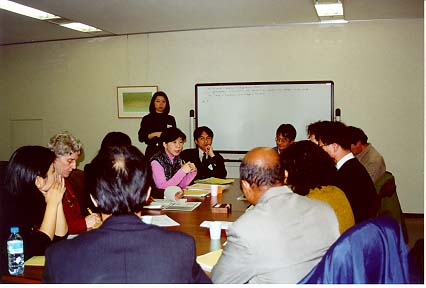- TOP
- 国際人権基準の動向
- FOCUS
- March 2001 - Volume 23
- Dialogue on Human Rights Education
FOCUS March 2001 Volume 23
Dialogue on Human Rights Education

While international documents may have defined human rights education clearly, "redefining" it for the sake of taking stock of its value in the context of one's society is still necessary. Educators from Japan, Bangladesh, Cambodia, Indonesia, south Korea, Mongolia, Pakistan, Sri Lanka, Taiwan and Thailand undertook a review of the meaning of human rights education in the context of Asia in a Dialogue held on January 27-29, 2001 in Osaka city.
The participants view human rights education as an essential component in building a better society. Human rights education in schools generally
- prepares students for their future role in society as adults;
- provides them with guide on how to live life in full (humane and dignified life)
- encourages them to act on their problems;
- empowers them (especially those belonging to a minority group1 or with certain disability) to change things such as the relationship between students and teachers, and resolve conflicts.
It is linked to the education reform movement that advocates change from examination-oriented education system to one that promotes total human development. It is not separated from the human rights movement (or its predecessor, the democracy movement as in the case of Korea) existing in society.
Values education, multicultural education, development education, peace education, among others, are related to human rights education. They are steps leading to human rights education. They cover concepts/issues that impinge on human rights.
Developing the curriculum
A human rights curriculum starts with understanding human rights-related values (primary level) that leads progressively to understanding human rights concepts (secondary level). Human rights issues should be understood at various contexts: personal, societal, and national and international. These contexts may correspond to the age levels of the students.
International human rights standards are already taught in a number of programs in Asia. There are materials that explain the provisions of international human rights instruments. Translation in easy language of the Universal Declaration of Human Rights, the Convention on the Elimination of Discrimination against Women, and the Convention on the Rights of the Child has been done in several countries.
Understanding international human rights standards is important because of the following reasons:
- these standards support the idea that all human beings are the equal and therefore share common standards (not sharing a common concept will lead to inward-looking attitude);
- they can be used to protect human rights;
- they are needed as members of the international community.
But this view does not apply to all countries. In Japan, international human rights standards are seen by many people as foreign and irrelevant for a number of reasons: the international human rights instruments use legal language, they do not apply to daily lives of people, there is no international pressure for their use, and even lawyers are not interested because they cannot be used in local courts. Though many Japanese travel outside the country, they consider international human rights standards as dispensable. For the Thais who travel abroad, however, they see the international human rights standards as important in protecting themselves.
In addition, human rights education should consider the hidden curriculum, that is, conditions in the schools should adhere to human rights principles.
Institutionalizing Human Rights Education
Experiences in institutionalizing human rights education in schools make use of the following:
- support from national constitutions, human rights law/policy/guidelines;
- partnership among NGOs, government educational institutions and schools, as well as with national human rights institutions, and the academic sector;
- support from international institutions such as the UN Office of the High Commissioner for Human Rights, UNICEF, UNESCO;
- program for teacher training, support from the community, partnership system among the different players;
- support program for the teachers - raising salary, lessening teaching load, providing incentives, undertaking measures to change behavior or attitude of teachers that violate human rights.
Institutionalization based on current experiences is not enlarging or creating bureaucracies but building relationships among the different players. One lesson learned is that no single institution is capable of implementing human rights education programs in all schools.
Endnotes
- Minority groups referred to here cover the Buraku (socially discriminated people in Japan), foreigners, and female students.
